Cars are a little like humans, in that they both have liquids inside them and if certain liquids come out, something is wrong. Likewise, the health of these liquids is critical, and they’re generally meant to be isolated from one another (i.e. not mixed). To that point, there exists in the nightmares of many car owners something called the “strawberry milkshake of death.” It is an automotive ailment that is almost always realized too late, leading to the death of an automatic transmission.
When transmission fluid gets too hot, it loses its ability to lubricate and cool the internals of an automatic transmission, potentially resulting in catastrophic damage. This is why many cars feature transmission coolers — radiators for your transmission fluid. Often, this comes in the form of a combined heat exchanger where part of the radiator handles thermal exchange for the coolant and part of the radiator handles thermal exchange for the transmission fluid — the two sections physically sealed from each other.
[Ed Note: Here’s a close look at an “end-tank cooler” or combined heat exchanger as Thomas puts it:
You’ll notice how the automatic transmission fluid is pumped into the “cold” radiator end-tank (i.e. coolant is flowing from the other tank, across the radiator core, and into this tank), where the transmission fluid flows into a heat exchanger that expels transmission fluid heat into the “cold” coolant in that tank. -DT]
It’s a compact solution that helps with packaging, plus the reduction in the number of parts needed cuts costs. On top of that, having the fluids close together may aid transmission fluid warm-up time (since the coolant can actually warm up the transmission in addition to cool it), but things can go badly wrong if the fluids in the two sections find a way to meet.

Unsurprisingly, as some of these combined heat exchangers age, they can suffer internal failure, allowing automatic transmission fluid to mix with coolant, seriously affecting the effectiveness of both fluids. Once this happens, most drivers simply won’t know about the intermixing until damage has occurred unless they look inside their coolant expansion tank and find that something isn’t right, as that’s the only visual indicator of this problem. While this isn’t a failure mode that happens to every car, it’s common enough to have earned a nickname: the Strawberry Milkshake of Death, or SMOD for short.
This nickname comes from the Nissan community, as 2005 to 2010 Nissan Frontier pickup trucks, XTerra SUVs, and Pathfinder SUVs with automatic transmissions were fitted with particularly problematic radiators. They failed internally early enough and often enough that owners were reporting problems more than a decade ago, such as this extremely upset XTerra owner venting their frustrations on the XTerra Nation forum, signing off with “Goodbye forever Nissan. Never again will I buy one.”

Even our own wrenching-contributor Stephen Walter Gossin once owned a nice Nissan XTerra with the Strawberry Milkshake of Death:


Failure rates were high enough that Nissan ultimately extended the warranty on these radiators from three years or 36,000 miles to ten years or 100,000 miles, with a catch. As the automaker wrote in the warranty extension announcement:
On a small percentage of vehicles, an internal crack on the oil cooler tube may occur leading to internal leakage of engine coolant. While the majority of vehicles will not experience this issue, for customer satisfaction purposes, Nissan has decided to further extend the coverage of the New Vehicle Limited Warranty on the radiator assembly, subject to certain customer co-pays that vary with age/mileage.
From what I’ve learned, beyond eight years or 80,000 miles up to nine years or 90,000 miles, the customer co-pay stood at $2,500. From beyond nine years or 90,000 miles up to 10 years or 100,000 miles, the customer co-pay stood at $3,000. That’s a huge co-pay, but if this failure took out the transmission, it did mean that a portion of the repairs would be covered by Nissan.
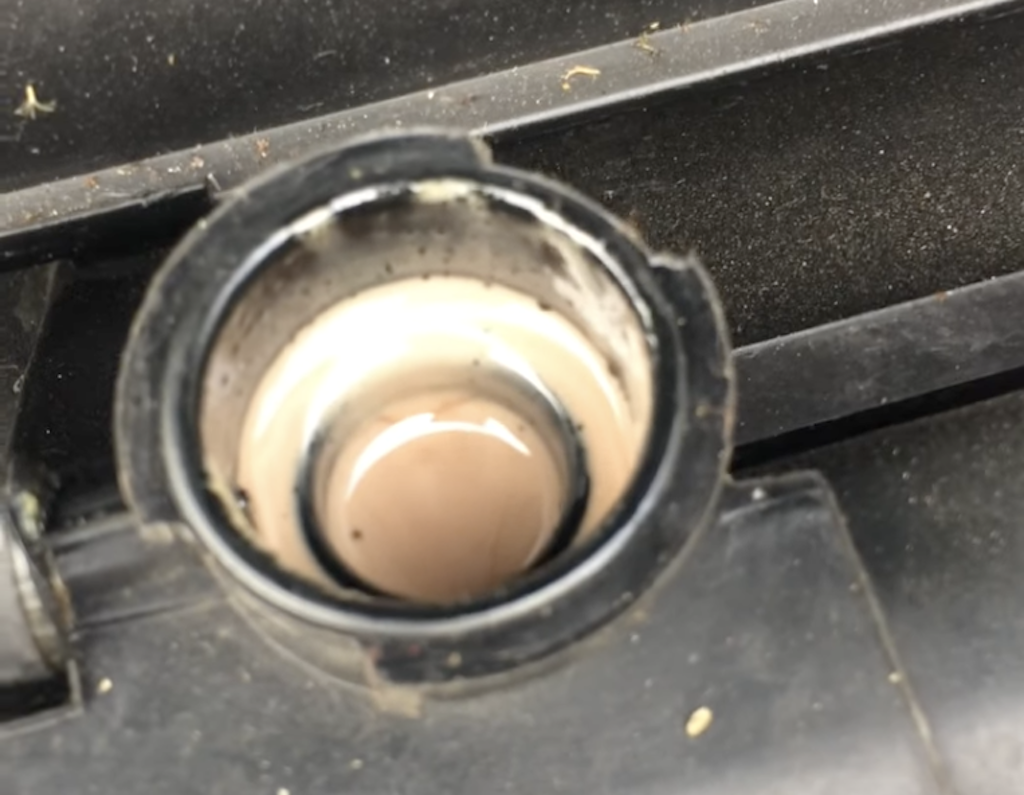
One of the best visuals out there of coolant and transmission fluid mixing happened on a Nissan Frontier.
Above is the video from YouTube user scenicriversfarmforestcons9616 that shows a better glimpse of what drivers may be looking at if their combination radiator and transmission cooler fails internally.
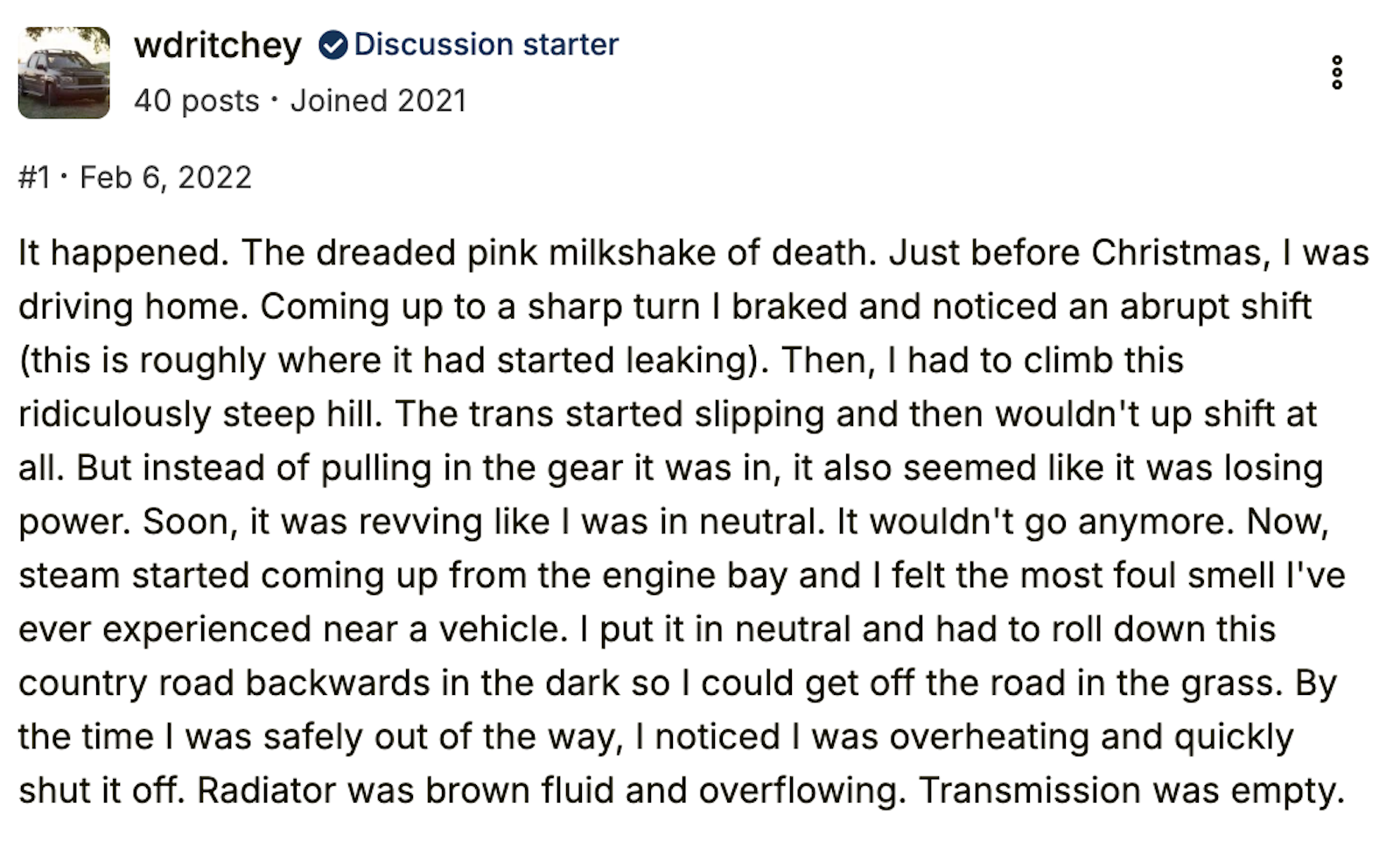
It’s worth noting that the mixture resulting from an internally failed radiator isn’t always pink, as fluid formulations vary across brands. This Honda Ridgeline owner on the Ridgeline Owners Club forum reports experiencing a mixing of coolant and transmission fluid, with the first obvious sign being strange transmission behavior.
Just before Christmas, I was driving home. Coming up to a sharp turn I braked and noticed an abrupt shift (this is roughly where it had started leaking). Then, I had to climb this ridiculously steep hill. The trans started slipping and then wouldn’t up shift at all. But instead of pulling in the gear it was in, it also seemed like it was losing power. Soon, it was revving like I was in neutral. It wouldn’t go anymore. Now, steam started coming up from the engine bay and I felt the most foul smell I’ve ever experienced near a vehicle. I put it in neutral and had to roll down this country road backwards in the dark so I could get off the road in the grass. By the time I was safely out of the way, I noticed I was overheating and quickly shut it off. Radiator was brown fluid and overflowing. Transmission was empty.
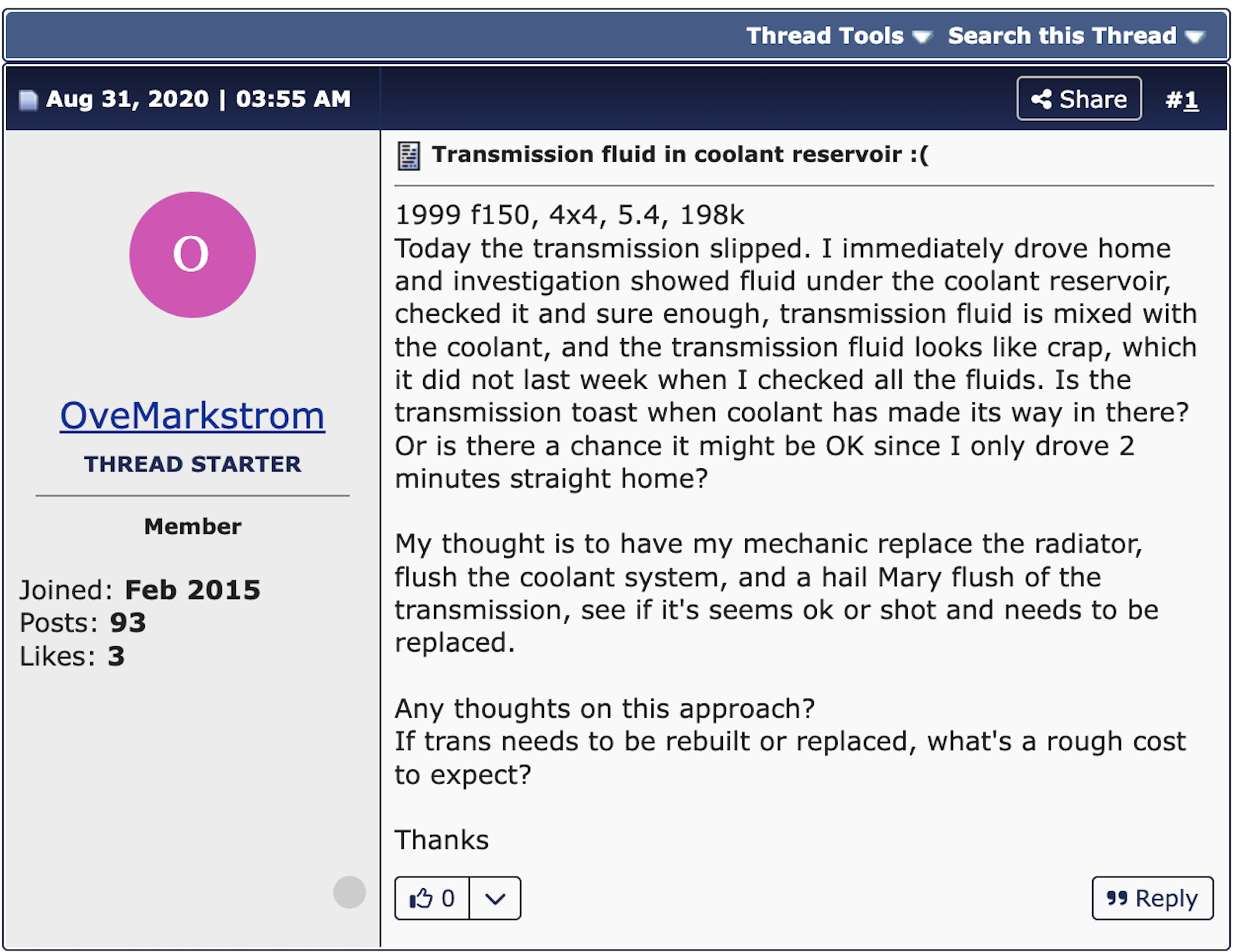
Indeed, the common thread with transmission fluid mixing with coolant due to internal radiator failure seems to be that owners often first notice it by feeling the transmission slip or shudder, and not always by noticing the engine overheat. This F-150 owner on F-150 Forum reports feeling the transmission slip, driving home and finding transmission fluid mixed with coolant in the coolant reservoir.
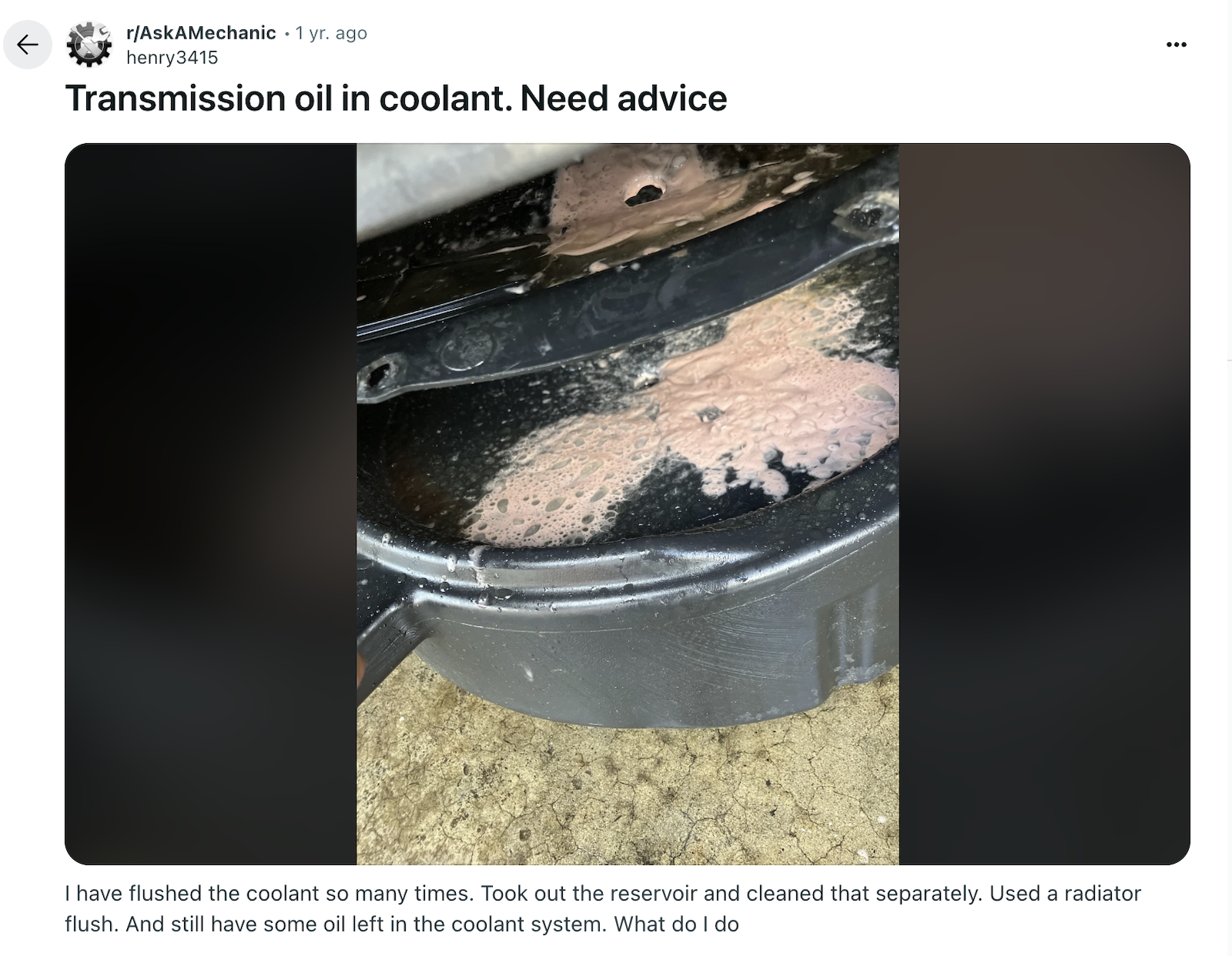
If the Strawberry Milkshake of Death happens to you (and it can happen on a variety of vehicles, including the beloved Jeep Cherokee XJ), and you catch it early enough, you may be able to get away with either replacing the internally failed radiator or routing the transmission cooler lines to a dedicated cooler and capping off the transmission line fittings on the radiator, performing a thorough coolant flush, doing a really good transmission flush and changing your transmission filter. Keep in mind, it can take some time to flush all the contaminated stuff out, as this Reddit user experienced. However, let it go on long enough, and you could be starting the prospect of transmission replacement right in the eyes. Considering this failure mode generally happens on older vehicles, and a transmission generally costs thousands of dollars, it could spell the end of a car.
So, if you own an older car with a combined radiator and transmission cooler, it’s not a bad idea to get in the habit of checking the coolant reservoir weekly. Don’t take the cap off unless the engine’s thoroughly cold, but a quick glimpse every now and then is either assurance that everything’s okay or an early warning if something’s wrong.
Top graphic image: Reddit
Support our mission of championing car culture by becoming an Official Autopian Member.

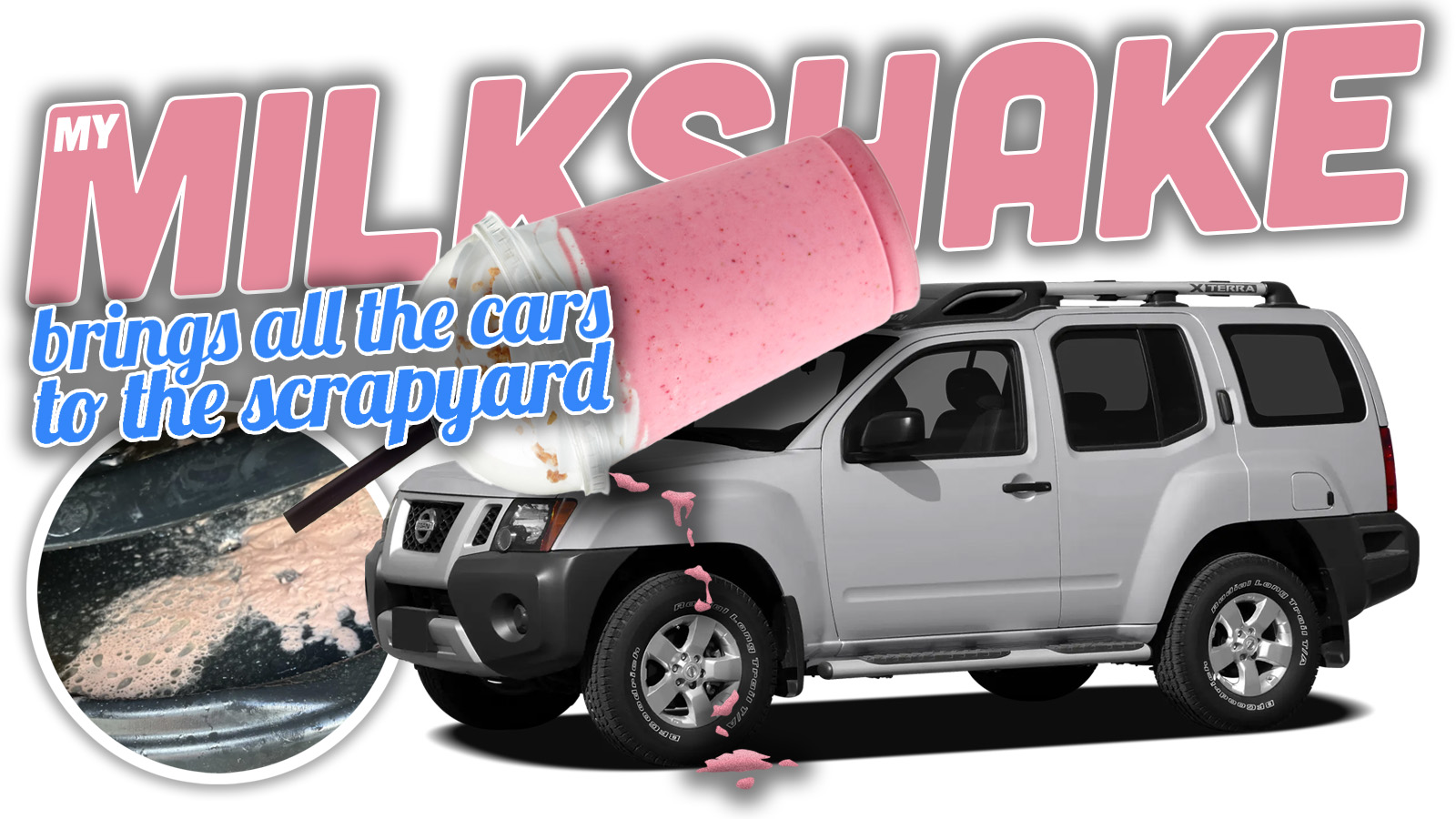







That XTerra was a nightmare.
Never again. Great piece, Thomas!
My Element’s on its 5th or 6th overheat and just blew the radiator. I’ve been expecting a blueberry shake of death but that K24 will not die!
gets especially annoying when companies like GM use both internal and an external cooler on the trucks. it would seem smarter to use just a single external cooler and bypass the potential problem altogether when needing added cooling capacity. but no, same base radiator, added lines and cooler when tow package added.
Had this with my 2006 Pathfinder. Needed a full transmission rebuild, was quite costly. I added an external transmission cooler to avoid this in the future.
This is also a known issue with early Mercedes W211 E-class 7G-tronic
Former Frontier owner here. Replace radiator every 75,000 miles. This is my recommended prevention of SMOD.
I don’t recommend bypass with external cooler.
And don’t be cheap when you by radiator.
So Mazdas get blueberry smoothies?
And the GM Dexcools look nearly the same when mixed, maybe a bit more orange at best. Mopar is a Grape Slushy.
All the more reason to snag one with the manual transmission.
If you can find one. Unfortunately the manual transmission option for the Frontier went the way of the dodo back in 2020. It was discontinued on Xterra when that SUV went out of production in 2015. With the discontinuation of the Versa this year the Z is the only vehicle left stateside in Nissan’s lineup that offers a wrist flicker!
I miss my 2011 Xterra P4X. I think the 2011 is a hit or miss if the rad was already fixed. Mine was the updated model and I had daydreams of hitting 500k. But it was totaled and I didn’t have the funds or time to turn it into a dedicated trail rig.
C’est la vie